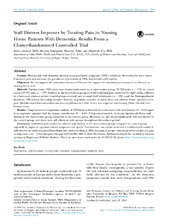| dc.contributor.author | Aasmul, Irene | en_US |
| dc.contributor.author | Husebø, Bettina | en_US |
| dc.contributor.author | Flo, Elisabeth | en_US |
| dc.date.accessioned | 2017-06-01T09:04:20Z | |
| dc.date.available | 2017-06-01T09:04:20Z | |
| dc.date.issued | 2016-12 | |
| dc.Published | Aasmul I, Husebø BS, Flo E. Staff distress improves by treating pain in nursing home patients with dementia: results from a cluster-randomized controlled trial. Journal of Pain Symptom and Management. 2016;52(6):795-805 | eng |
| dc.identifier.issn | 0885-3924 | |
| dc.identifier.uri | https://hdl.handle.net/1956/15913 | |
| dc.description.abstract | Context. Most people with dementia develop neuropsychiatric symptoms (NPSs), which are distressing for their carers. Untreated pain may increase the prevalence and severity of NPSs and thereby staff burden. Objectives. We investigated the association between NPSs and the impact of individual pain treatment on distress in nursing home staff. Methods. Nursing home (NH) units were cluster-randomized to an intervention group (33 NH units; n ¼ 175) or control group (27 NH units; n ¼ 177). Patients in the intervention group received individual pain treatment for eight weeks, followed by a four-week washout period; control groups received care as usual. Staff informants (n ¼ 138) used the Neuropsychiatric InventoryeNH version (including caregiver distress) as primary outcome to assess their own distress. Other outcomes were pain (Mobilization-Observation-Behavior-Intensity-Dementia-2 Pain Scale) and cognitive functioning (MinieMental State Examination). Results. Using hierarchical regression analysis, all NPS items at baseline were associated with staff distress (P < 0.01) apart from euphoria; agitation had the largest contribution (b ¼ 0.24). Using mixed models, we found significantly lower staff distress in the intervention group compared to the control group. Moreover, we also found significantly reduced distress in the control group, and there were still effects in both groups throughout the washout period. Conclusion. Individual pain treatment reduced staff distress in the intervention group compared to control group especially in regard to agitation-related symptoms and apathy. Furthermore, our results indicated a multifactorial model of staff distress, in which enhanced knowledge and understanding of NPSs and pain in people with advanced dementia may play an important role. | en_US |
| dc.language.iso | eng | eng |
| dc.publisher | Elsevier | eng |
| dc.rights | Attribution CC BY-NC-ND | eng |
| dc.rights.uri | http://creativecommons.org/licenses/by-nc-nd/4.0/ | eng |
| dc.subject | Staff distress | eng |
| dc.subject | staff education | eng |
| dc.subject | Nursing home | eng |
| dc.subject | Dementia | eng |
| dc.subject | neuropsychiatric symptoms | eng |
| dc.subject | Pain | eng |
| dc.title | Staff distress improves by treating pain in nursing home patients with dementia: results from a cluster-randomized controlled trial | en_US |
| dc.type | Peer reviewed | |
| dc.type | Journal article | |
| dc.date.updated | 2017-05-09T09:46:23Z | |
| dc.description.version | publishedVersion | en_US |
| dc.rights.holder | Copyright 2016 The Author(s) | |
| dc.identifier.doi | https://doi.org/10.1016/j.jpainsymman.2016.07.004 | |
| dc.identifier.cristin | 1388965 | |
| dc.source.journal | Journal of Pain Symptom and Management | |

